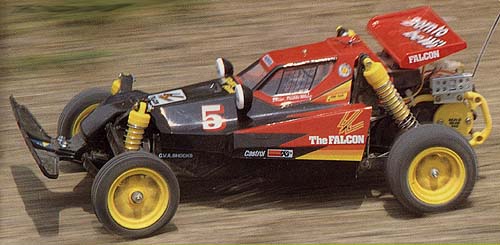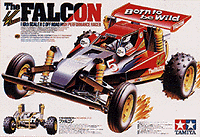Analysis of individual cars
The Falcon (58056)

The Falcon was kit number 56 from Tamiya. A 1/10 scale 2WD off-road car, it was designed as an entry level kit.
Specifications
- 1/10 scale off-road vehicle
- 2 wheel drive
- Tub-type plastic chassis
- Fully independent suspension all around with dogbone style rear axle drive and trailing arms
- Four high-capacity coil spring over oil filled dampers
- RS-540 stock motor
- Narrow ribbed front tires with wide pin spike rear tires
- Lexan body
Description
This was an absolutely marvelous entry level car. Many of the "beginner" cars that came before were really not very suited for true off-road use. Typically they utilized a live axle rear suspension and no oil damping on the shocks. This made for a tricky handling car. The Falcon changed all of this. A nice independent suspension that is fully damped by oil filled shocks.
And as an entry level car, it was very easy to assemble. The gear box featured oversized gears that were easy to manipulate during assembly. Plus the vehicle featured a low parts count which meant assembly time was cut to under 2 hours.
Tamiya also saw to long term durability by beefing up the size and thickness of the front bumper. As well, a rear motor guard and skid plate was standard equipment. Overall the kit was a real nice quality unit.
Performance was very good for an entry level car. The fully independent suspension really helped. Unlike a Hornet or Grasshopper, the unsprung weight of the rear drive wheels is low so compliance over bumpy roads is very good. The Falcon is also a car that can grow with you as you learn more about the sport. The suspension can be tuned by using the shock collars provided and by using different pistons and shock oils. And by sharing wheel adapters with the Tamiya Fox, the car launched with a full load of optional and aftermarket wheels available.
The only problem with the Falcon had to do with its rear dogbone setup. They were very sensitive to debris and lack of lubrication. Without properly lubrication the dogbones would strip very rapidly. For whatever reason, Tamiya chose to use plastic cups and dogbones with steel shaft inserts. As you can imagine the plastic parts rapidly wore out. You can basically forget about using high output engines in this car.
The other problem was that the dogbones would fall out at certain extreme suspension angles. This happened mostly during off-road excursions, but the up side is that you can basically force them back in without taking anything apart! Tamiya cars are plastic after all.
This was a very popular off-road kit for Tamiya. Because the difference in price between this kit and the Hornet was about $20, a lot of beginners walked out of the hobby store with a Falcon under their arm.
Many of the components in the Falcon would later be used in other kits such as the Sonic Fighter and Striker.
Historical Significance
 The Falcon was an excellent car for the beginner and it sold well for Tamiya. Unfortunately, its historical significance is limited. There was nothing really radical about the design of the chassis and the body styling was "typical" for the time. Further, as used Tamiyas go, they’re quite plentiful.
The Falcon was an excellent car for the beginner and it sold well for Tamiya. Unfortunately, its historical significance is limited. There was nothing really radical about the design of the chassis and the body styling was "typical" for the time. Further, as used Tamiyas go, they’re quite plentiful.
Given all of this, I would encourage collecting a new-built unit or a brand new shrink wrapped kit. And although the drivetrain was used in two other Tamiya cars later, they were not significant cars either and this detracts from the collectability of the original.
Additional Notes
As with many kits of this era, check to see that the 3 step speed control is intact and in good shape. Many were tossed in favor of an ESC. You’ll also want to ensure that the receiver battery holder (a yellow plastic tray) is included because that too was tossed on a regular basis. Also, you’ll want to check the condition of the tub chassis near the front mount points as it tends to crack in that area. And of course, those dogbones should be checked as well.
Generally the Tamiya Falcon is a reliable sturdy car and they hold up well as used kits. Parts are surprisingly easy to get a hold of. Only a few pieces are tough to find. The rear tires and wheels, and the lexan body is starting to become rare.
Rating
- Collectability – 5 out of 10
- Fun to drive – 7 out of 10
- Parts availability – 8 out of 10
